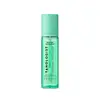What's inside
What's inside
 Key Ingredients
Key Ingredients

 Benefits
Benefits

 Ingredients Side-by-side
Ingredients Side-by-side

Water
Skin ConditioningGlycerin
HumectantDihydroxyacetone
Skin ConditioningButylene Glycol
HumectantSorbitol
HumectantCentella Asiatica Leaf Extract
Skin ConditioningSodium Hyaluronate
HumectantAscorbic Acid
AntioxidantGlycyrrhiza Glabra Root Extract
BleachingPanthenol
Skin ConditioningHyaluronic Acid
HumectantGlucose
HumectantXylitylglucoside
HumectantAnhydroxylitol
HumectantXylitol
HumectantSodium Gluconate
Skin ConditioningSodium Benzoate
MaskingPotassium Sorbate
Preservative
 Reviews
Reviews

Ingredients Explained
These ingredients are found in both products.
Ingredients higher up in an ingredient list are typically present in a larger amount.
Dihydroxyacetone, or DHA, is a simple sugar. It is frequently used in self-tanning products.
DHA binds to the amino acids in your dead skin cells to create a brown/orange color. Darkening begins to kick in a few hours after application and will continue to develop for up to 3 days. This ingredient can be drying.
Both the US and the EU have approved DHA in self-tanning products. In the EU, DHA is allowed at a maximum concentration of 10%. Most tanning products usually contain amounts between 3-5%.
If you are pregnant or have underlying medical conditions, it is best to speak with a dermatologist about using self-tanning products.
Learn more about DihydroxyacetoneGlycerin is already naturally found in your skin. It helps moisturize and protect your skin.
A study from 2016 found glycerin to be more effective as a humectant than AHAs and hyaluronic acid.
As a humectant, it helps the skin stay hydrated by pulling moisture to your skin. The low molecular weight of glycerin allows it to pull moisture into the deeper layers of your skin.
Hydrated skin improves your skin barrier; Your skin barrier helps protect against irritants and bacteria.
Glycerin has also been found to have antimicrobial and antiviral properties. Due to these properties, glycerin is often used in wound and burn treatments.
In cosmetics, glycerin is usually derived from plants such as soybean or palm. However, it can also be sourced from animals, such as tallow or animal fat.
This ingredient is organic, colorless, odorless, and non-toxic.
Glycerin is the name for this ingredient in American English. British English uses Glycerol/Glycerine.
Learn more about GlycerinThis is the synthetic salt of gluconic acid, a form of PHA and mild exfoliant.
It is mainly used to stabilize oil and butter formulations from going bad. Sodium gluconate is a humectant, pH regulator, and chelating agent.
Chelating agents help neutralize unwanted metals from affecting the formulation.
Sodium gluconate is water-soluble.
Learn more about Sodium GluconateSodium Hyaluronate is hyaluronic acid's salt form. It is commonly derived from the sodium salt of hyaluronic acid.
Like hyaluronic acid, it is great at holding water and acts as a humectant. This makes it a great skin hydrating ingredient.
Sodium Hyaluronate is naturally occurring in our bodies and is mostly found in eye fluid and joints.
These are some other common types of Hyaluronic Acid:
Learn more about Sodium HyaluronateWater. It's the most common cosmetic ingredient of all. You'll usually see it at the top of ingredient lists, meaning that it makes up the largest part of the product.
So why is it so popular? Water most often acts as a solvent - this means that it helps dissolve other ingredients into the formulation.
You'll also recognize water as that liquid we all need to stay alive. If you see this, drink a glass of water. Stay hydrated!
Learn more about Water